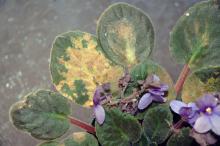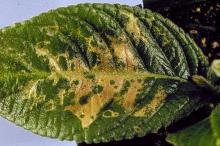Cause A rapid drop in leaf temperature for a few seconds drastically decreases photosynthetic activity and irreversibly destroys the ultrastructural composition of leaf palisade cells. Generally occurs in the home when African violets are watered from the top with cold water or when cold water splashes onto leaves. This injury, however, can be caused by immersion in 77°F water if the leaf temperature before the immersion was higher than 95°F. Thus, leaf spot is caused by a temperature difference, and does not always require a "chilling" temperature. The fate to irreversible injury does not depend on the extent of coldness or chilled period to which leaf was exposed but the temperature gradient at the boundary between the chilled and unchilled area, which seems to be crucial in the formation of leaf spot.
The sensitivity varied among cultivars where Maui and New Jersey were relatively more tolerant to a rapid temperature drop by 15°C (30° to 15°C) than cultivars Ritali and Tamiko.
Symptoms White to yellow ringspots, lines, or arcs develop on the leaves.
Cultural control
- Water plants from below, and avoid splashing cold water on leaves.
- Use room temperature water to irrigate plants.
- Grow less sensitive cultivars.
Reference Yang, S.J., Hosokawa, M., Mizuta, Y., Yun, J.G., Mano, J., and Yazawa, S. 2001. Antioxidant capacity is correlated with susceptibility to leaf spot caused by a rapid temperature drop in Saintpaulia (African violet). Scientia Horticulturae 88:59-69.



